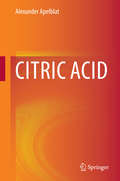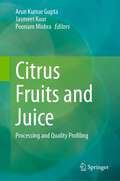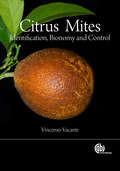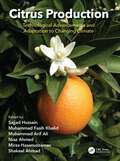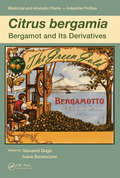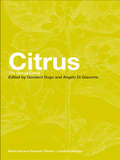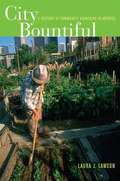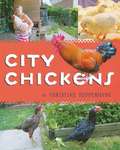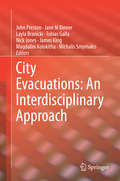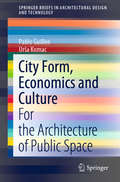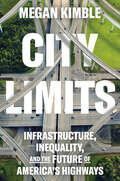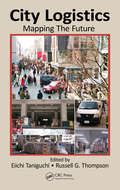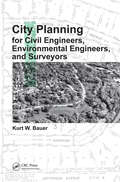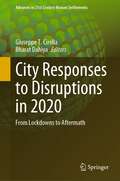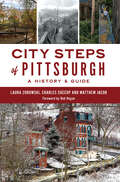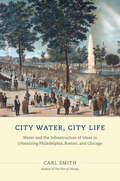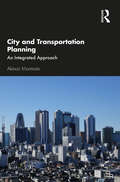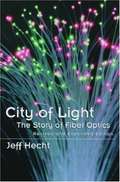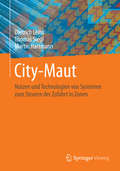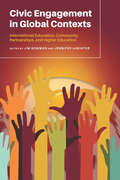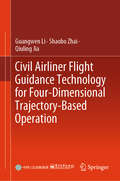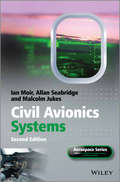- Table View
- List View
Citric Acid
by Alexander ApelblatThis monograph is devoted to different aspects associated with citric acid, inorganic citrates and their aqueous and organic solutions. It includes information about properties, occurrence and technological applications of citric acid and inorganic citrates. Phase equilibria - melting, freezing, boiling, vapour pressures, solubilities of citric acid in water, organic solvents and ternary systems are presented, correlated, and analyzed. Dynamic properties - viscosities, diffusion coefficients, electrical conductivities and surface tensions are examined. Mathematical representations of citric acid dissociation, in electrolyte solutions and in buffers are discussed. Citric acid chemistry - syntheses of citric acid, neutralization, degradation, oxidation, esterification, formation of anhydrides, amides and citrate-based siderophores is reviewed.
Citrus Essential Oils
by Masayoshi SawamuraCommercially used for food flavorings, toiletry products, cosmetics, and perfumes, among others, citrus essential oil has recently been applied physiologically, like for chemoprevention against cancer and in aromatherapy. Citrus Essential Oils: Flavor and Fragrance presents an overview of citrus essential oils, covering the basics, methodology, and applications involved in recent topics of citrus essential oils research. The concepts, analytical methods, and properties of these oils are described and the chapters detail techniques for oil extraction, compositional analysis, functional properties, and industrial uses. This book is an unparalleled resource for food and flavor scientists and chemists.
Citrus Fruits and Juice: Processing and Quality Profiling
by Arun Kumar Gupta Jasmeet Kour Poonam MishraThis book provides a comprehensive overview of current scientific research on citrus juice and by-product technologies. It covers various aspects of citrus and its processing, encompassing biochemistry, advanced juice processing technology, and health considerations. The book also delves into testing methodologies for various chemicals, phytochemicals, and bitter compounds. Furthermore, it presents innovative and efficient methods for the detection, quantification, and removal of bitter chemicals to enhance the commercial appeal of bitter cultivars. A special emphasis is placed on non-thermal processing, exploring the multifaceted aspects of citrus juice processing, including by-products. In addition, the book addresses the safety aspects of processed juice and related products, a topic often overlooked in other works. It particularly highlights the packaging requirements for juice and related goods. This book is tailored for researchers, students, and professionals in the food processing industry.
Citrus Mites: Identification, Bionomy and Control
by Vincenzo VacanteCitrus pests are a serious issue for crop growers, causing problems in yield and economic losses. Citrus Mites is a comprehensive study of mites harmful to citrus plants from all citrus growing regions around the world. Providing a useful resource for identifying citrus crop pests, the text will also address methods of removal from plants, describe symptoms of damage caused by pests and discuss methods of eradication and control, making it essential for horticulturalists, pomologists and acarologists as well as practitioners, researchers and students of crop protection and pest management.
Citrus Production: Technological Advancements and Adaptation to Changing Climate
by Mirza Hasanuzzaman Sajjad Hussain Shakeel Ahmad Niaz Ahmed Muhammad Fasih Khalid Muhammad Arif AliThe citrus industry is one of the world's most important fruit production industries, but global climate change, pests, diseases, and improper handling are affecting plant yields. Citrus Production: Technological Advancements and Adaptation to Changing Climate presents information on advancements in the citrus industry examining various aspects of citrus from its production to harvest. It looks at the challenges and approaches in stress tolerance improvements, increasing citrus crop productivity, and reducing postharvest losses. The book details taxonomy, genetic diversity, and metabolic and molecular responses in citrus crops, as well as abiotic and biotic stresses affecting citrus production. Featuring numerous full-color illustrations throughout, this book poses new harvesting techniques along with postharvest physiology of citrus fruits, devising strategies to prevent crop losses. Citrus Production: Technological Advancements and Adaptation to Changing Climate is an essential resource for researchers, academicians, and scientists looking to expand their knowledge of citrus, particularly horticulturists, food scientists, and botanists.
Citrus bergamia: Bergamot and its Derivatives
by Giovanni Dugo Ivana BonaccorsiIn Calabria, Italy, where bergamot has been successfully cultivated since the eighteenth century, it is commonly defined as "the prince of the Citrus genus." Written by an international panel of experts from multiple disciplines, Citrus bergamia: Bergamot and its Derivatives represents the most complete treatise on bergamot and its derivatives curr
Citrus: The Genus Citrus (Medicinal And Aromatic Plants - Industrial Profiles Ser.)
by Giovanni Dugo Angelo Di GiacomoThe world production of citrus fruit has risen enormously, leaping from forty-five million tons a year to eighty-five million in the last 30 years. Today, the potential applications of their essential oils are growing wider, with nearly 40% of fresh produce processed for industrial purposes.Citrus: The Genus Citrus offers comprehensive cove
City Bountiful: A Century of Community Gardening in America
by Laura J. LawsonSince the 1890s, providing places for people to garden has been an inventive strategy to improve American urban conditions. There have been vacant-lot gardens, school gardens, Depression-era relief gardens, victory gardens, and community gardens―each representing a consistent impulse to return to gardening during times of social and economic change. In this critical history of community gardening in America, the most comprehensive review of the greening of urban communities to date, Laura J. Lawson documents the evolution of urban garden programs in the United States. Her vibrant narrative focuses on the values associated with gardening, the ebb and flow of campaigns during times of social and economic crisis, organizational strategies of these primarily volunteer campaigns, and the sustainability of current programs.
City Cycling
by John Pucher Ralph BuehlerBicycling in cities is booming, for many reasons: health and environmental benefits, time and cost savings, more and better bike lanes and paths, innovative bike sharing programs, and the sheer fun of riding. City Cycling offers a guide to this urban cycling renaissance, with the goal of promoting cycling as sustainable urban transportation available to everyone. It reports on cycling trends and policies in cities in North America, Europe, and Australia, and offers information on such topics as cycling safety, cycling infrastructure provisions including bikeways and bike parking, the wide range of bike designs and bike equipment, integration of cycling with public transportation, and promoting cycling for women and children. City Cycling emphasizes that bicycling should not be limited to those who are highly trained, extremely fit, and daring enough to battle traffic on busy roads. The chapters describe ways to make city cycling feasible, convenient, and safe for commutes to work and school, shopping trips, visits, and other daily transportation needs. The book also offers detailed examinations and illustrations of cycling conditions in different urban environments: small cities (including Davis, California, and Delft, the Netherlands), large cities (including Sydney, Chicago, Toronto and Berlin), and "megacities" (London, New York, Paris, and Tokyo). These chapters offer a closer look at how cities both with and without historical cycling cultures have developed cycling programs over time. The book makes clear that successful promotion of city cycling depends on coordinating infrastructure, programs, and government policies.
City Evacuations: An Interdisciplinary Approach
by John Preston James King Jane M Binner Layla Branicki Tobias Galla Nick Jones Magdalini Kolokitha Michalis SmyrnakisEvacuating a city is a complex problem that involves issues of governance, preparedness education, warning, information sharing, population dynamics, resilience and recovery. As natural and anthropogenic threats to cities grow, it is an increasingly pressing problem for policy makers and practitioners. The book is the result of a unique interdisciplinary collaboration between researchers in the physical and social sciences to consider how an interdisciplinary approach can help plan for large scale evacuations It draws on perspectives from physics, mathematics, organisation theory, economics, sociology and education Importantly it goes beyond disciplinary boundaries and considers how interdisciplinary methods are necessary to approach a complex problem involving human actors and increasingly complex communications and transportation infrastructures. Using real world case studies and modelling the book considers new approaches to evacuation dynamics. It addresses questions of complexity, not only in terms of theory, but examining the latest challenges for cities and emergency responders Factors such as social media, information quality and visualisation techniques are examined to consider the 'new' dynamics of warning and informing, evacuation and recovery.
City Form, Economics and Culture: For the Architecture of Public Space (SpringerBriefs in Architectural Design and Technology)
by Pablo Guillen Urša KomacThis is a book about how cities occupy space. We are not interested in architectural masterpieces, but the tools for reinventing city life. We try to provide a framework for the architecture and design of public space without aesthetic considerations. We identify several defining factors. First of all, history as the city today very much depends on how it was yesterday. The geographical location and the technology available at a point of time both play a constraining role in what can be done as well. Culture, in the form of social norms, laws and regulations, also restricts what is possible to do. On the other hand, culture is also important in guiding the ideas and aspirations that together inform what society wants the city to be. The city needs government intervention, or regulation, to ameliorate the problem posed by a tangle of externalities and public goods. We focus on two comparative case studies: the evolution of urban form in the US and how it stands in a sharp contrast with the evolution of urban form in Japan. We emphasise the difference in regulations between both jurisdictions. We study how differences in technological choices driven by culture (i.e. racial segregation), geography (i.e. the availability of land) and history (i.e. the mobility restrictions of the Tokugawa period) result in vast differences in mobility regarding the share of public transport, walking and cycling versus motorised private transport. American cities are constrained by rules that are much further from the neoliberal economic idea of free and competitive markets than the Japanese ones. Japanese planning promotes competition and through a granular, walkable city dotted with small shops, fosters variety in the availability of goods and services. We hypothesise how changing regulations could change the urban form to generate a greater variety of goods and to foster the access to those goods through a more equitable distribution of wealth. Critically, we point out that a desirably denser city must rely on public transport, and we also study how a less-dense city can be made to work with public transport. We conclude by claiming that changes in regulations are very unlikely to happen in the US, as it would require deep cultural changes to move from local to a more universal and less excluding public good provision, but they are both possible and desirable in other jurisdictions.
City Limits: Infrastructure, Inequality, and the Future of America's Highways
by Megan KimbleAn eye-opening investigation into how our ever-expanding urban highways accelerated inequality and fractured communities—and a call for a more just, sustainable path forward &“Megan Kimble manages to turn a book about transportation and infrastructure into a fascinating human drama.&”—Michael Harriot, New York Times bestselling author of Black AF HistoryEvery major American city has a highway tearing through its center. Seventy years ago, planners sold these highways as progress, essential to our future prosperity. The automobile promised freedom, and highways were going to take us there. Instead, they divided cities, displaced people from their homes, chained us to our cars, and locked us into a high-emissions future. And the more highways we built, the worse traffic got. Nowhere is this more visible than in Texas. In Houston, Dallas, and Austin, residents and activists are fighting against massive, multi-billion-dollar highway expansions that will claim thousands of homes and businesses, entrenching segregation and sprawl.In City Limits, journalist Megan Kimble weaves together the origins of urban highways with the stories of ordinary people impacted by our failed transportation system. In Austin, hundreds of families will lose child care if a preschool is demolished to expand Interstate 35. In Houston, a young Black woman will lose her brand-new home to a new lane on Interstate 10—just blocks away from where a seventy-four-year-old nurse lost her home in the 1960s when that same highway was built. And in Dallas, an urban planner has improbably found himself at the center of a national conversation about highway removal. What if, instead of building our aging roads wider and higher, we removed those highways altogether? It&’s been done before, first in San Francisco and, more recently, in Rochester, where Kimble traces how highway removal has brought new life to a divided city.With propulsive storytelling and ground-level reporting, City Limits exposes the enormous social and environmental costs wrought by our allegiance to a life of increasing speed and dispersion, and brings to light the people who are fighting for a more sustainable, connected future.
City Logistics: Mapping The Future
by Eiichi Taniguchi Russell G. ThompsonCity Logistics: Mapping The Future examines the key concepts of city logistics along with the associated implementation issues, methodologies, and policy measures. Chronicling the growth of city logistics as a discipline and how planning and policy have improved practice over the last ten years, it details the technologies, policies, and plans that
City Planning for Civil Engineers, Environmental Engineers, and Surveyors
by Kurt W. BauerWhile engineers and surveyors are not urban planners, they are often engaged in urban development. Therefore, a high degree of competence in civil engineering specialties such as surveying and mapping, highway and transportation engineering, water resources engineering, environmental engineering, and, particularly, municipal engineering requires an
City Responses to Disruptions in 2020: From Lockdowns to Aftermath (Advances in 21st Century Human Settlements)
by Bharat Dahiya Giuseppe T. CirellaThis book presents the integrating of economics and urban geography to create a framework of cooperation around the idea of urban economic stability. It explores these disciplines through the economic lens and creates a collaborative environment for addressing the global challenges caused by the COVID-19 pandemic and future global shocks. Environmental advocates and proponents of economic growth are increasingly at odds—having looked at the economic impact of the decline of the environment as well as the environmental loss that occurs with unchecked growth and urbanization. The outbreak of the COVID-19 pandemic changed the global scene. The world shook in its foundations, as a number of countries’ lockdown affected not only the global economy but also society and the environment. The global community has seen the negative impact of COVID-19 on our economies. There have been steep declines in gross domestic product, job losses have been in the millions, and people have seen their incomes fall. An unplanned shutdown has taken its toll and has been a shock to the economies of the world. Past shocks and how they have impacted urban economies as well as for how long are core to bettering our understanding of present and future urban economic change. The underlying economic factors that make a shock more damaging to certain economies or industries, as well as understanding these vulnerabilities, help entities recover from economic shocks and allow them to better understand how impacts on individual businesses can be implemented. The pandemic revealed the need to adopt a global development approach, taking into consideration four dimensions: global value chains, debt, digitalization, and the environment. Topics related to the causation and lockdown are explored through a number of case studies from around the world.
City Steps of Pittsburgh: A History & Guide (History & Guide)
by Matthew Jacob Laura ZurowskiExploring Pittsburgh's Ups and Downs In Pittsburgh, the elevation varies wildly, fluctuating 660 feet from highest to lowest points throughout the area and making it one of the hilliest cities in the United States. Throughout this unruly and physically challenging landscape, the city's first mass transportation system was built - a steadily expanding network of public stairways, locally referred to as city steps, these flights of stairs are a throwback to a very different time in history and a very different Pittsburgh. Authors Laura Zurowski, Charles Succop and Matthew Jacob present the history of the Steel City steps and a walking guide to their scenic locations today.
City Water, City Life: Water and the Infrastructure of Ideas in Urbanizing Philadelphia, Boston, and Chicago
by Carl SmithA city is more than a massing of citizens, a layout of buildings and streets, or an arrangement of political, economic, and social institutions. It is also an infrastructure of ideas that are a support for the beliefs, values, and aspirations of the people who created the city. In "City Water, City Life," celebrated historian Carl Smith explores this concept through an insightful examination of the development of the first successful waterworks systems in Philadelphia, Boston, and Chicago between the 1790s and the 1860s. By examining the place of water in the nineteenth-century consciousness, Smith illuminates how city dwellers perceived themselves during the great age of American urbanization. aBut "City Water, City Life" is more than a history of urbanization. aIt is also a refreshing meditation on water as a necessity, as a resource for commerce and industry, and as an essentialOCoand centralOCopart of how we define our civilization.
City and Transportation Planning: An Integrated Approach
by Akinori MorimotoMany urban and transportation problems, such as traffic congestion, traffic accidents, and environmental burdens, result from poor integration of land use and transportation. This graduate-level textbook outlines strategies for sustainably integrating land use and transportation planning, addressing the impact on land use of advanced transport like light rail transit and autonomous cars, and the emerging focus on cyber space and the role of ICT and big data in city planning. The text also explores how we can create sustainable cities for the future. In contrast to the "compact city", which has been proposed as an environmentally friendly urban model, recent years have seen an acceleration in the introduction of ICT-based "smart city". As people’s lives are drastically changed by COVID-19, a new form of city is being explored. The new concept of a "smart sharing city" is introduced as an urban model that wisely integrates physical and cyber space, and presents a way to solve future urban issues with new technologies.
City at the End of Time
by Greg BearDo you dream of a city at the end of time? In a time like the present, on a world that may or may not be our own, three young people-Ginny, Jack, and Daniel-dream of a fabulous, decadent city in the distant future: the Kalpa. The dreams of Ginny and Jack overtake them without warning, leaving their bodies behind while carrying their consciousnesses forward, into the minds of two inhabitants of the Kalpa-a would-be warrior, Jebrassy, and an inquisitive explorer, Tiadba-who have been genetically retroengineered to possess qualities of ancient humanity. In turn, the dreams of Tiadba and Jebrassy carry them back, into the minds of Jack and Ginny. As for Daniel: he dreams of an empty darkness--all his future holds. But more than dreams link Ginny, Jack, and Daniel. They are fate-shifters, born with the ability to skip like stones across the surface of the fifth dimension, inhabiting alternate versions of themselves. And they are each guardians of an object whose origins and purpose are unknown, a gnarled, stony artifact called a sum-runner that persists unchanged through all versions of time. They can save the future, but they are being hunted down.
City of Light: The Story of Fiber Optics
by Jeff HechtThis paperback edition of a work first published by Oxford in 1999 has a new final chapter, on the second phase in fiber optics, when stock in bandwidth technology became overvalued and went bust in the late 1990s. The book is valuable for its clear descriptions of the technology while also tracing the careers and development of the people and companies that made this a dominant industry. Hecht, an engineer, writes on science and technology in the UK. Annotation ©2004 Book News, Inc., Portland, OR (booknews. com)
City-Maut: Nutzen und Technologien von Systemen zum Steuern der Zufahrt in Zonen
by Dietrich Leihs Thomas Siegl Martin HartmannDieses Buch bietet eine umfassende Einf#65533;hrung in die Thematik st#65533;dtischen Zufahrtsmanagements im europ#65533;ischen Kontext. Dabei werden sowohl gesetzliche, technologische als auch volkswirtschaftliche Aspekte in Betracht gezogen. So kontrovers die Diskussion #65533;ber st#65533;dtische Zufahrtsmanagement-Systeme wie beispielsweise City-Maut gef#65533;hrt wird, so wenig kann ignoriert werden, dass diese Instrumente als Verkehrsmanagementma#65533;nahme aus dem heutigen Alltag nicht mehr wegzudenken sind, ja bereits Fu#65533; fassten und sich steigender Verwendung erfreuen.
Civic Engagement in Global Contexts: International Education, Community Partnerships, and Higher Education
by Jennifer DeWinter Jim BowmanThis volume examines the role of writing, rhetoric, and literacy programs and approaches in the practice of civic engagement in global contexts. Writing programs have experience in civic engagement and service learning projects in their local communities, and their work is central to developing students’ literacy practices. Further, writing programs compel student writers to attend to audience needs and rhetorical exigencies as well as reflect on their own subject positions. Thus, they are particularly situated to partner with other units on college campuses engaged in global partnerships. Civic Engagement in Global Contexts provides examples and evidence of the critical self-reflection and iteration with community partners that make these projects important and valuable. Throughout its thirteen chapters, this collection provides practical pedagogical and administrative approaches for writing studies faculty engaging with global learning projects, as well as nuanced insight into how to navigate contact zones from the planning stages of projects to the hard work of self-reflection and change. Partnerships and projects across national borders compel the field of rhetoric and composition to think through the ethics of writing studies program design and teaching practices. Doing this difficult work can disrupt presumptive notions of ownership that faculty and administrators hold concerning the fields involved in these projects and can even lead to decentering rhetoric/composition and other assumptions held by US-based institutions of higher education. Civic Engagement in GlobalContexts will be useful to instructors, advisors, and project managers of students in faculty-led project learning in overseas settings, international service learning through foreign study programs, and foreign study itself and to faculty members introducing civic engagement and community-based learning projects with foreign students in overseas institutions. Contributors: Olga Aksakalova, James Austin, Maria de Lourdes Caudillo Zambrano, Rebecca Charry Roje, Patricia M. Dyer, Tara E. Friedman, Bruce Horner, Kathryn Johnson Gindlesparger, Adela C. Licona, Ian Mauer, Joyce Meier, Susan V. Meyers, Sadia Mir, Stephen T. Russell
Civil Airliner Flight Guidance Technology for Four-Dimensional Trajectory-Based Operation
by Guangwen Li Shaobo Zhai Qiuling JiaThis book focuses on achieving precision guidance and timely arrival in flight. The content comprehensively describes the civil aircraft flight guidance technology for four-dimensional trajectory-based operation. The main content of this book is the summary of the author's team's research work on flight management systems and flight guidance technology over the past decade, including flight plan analysis and transition path construction, four-dimensional trajectory planning and re-planning, high-precision flight guidance commands calculation, FMS landing system, etc. The theoretical methods described in the book have been verified by pre-research and practical engineering projects, which are of great theoretical significance and engineering application value. This book is used as a reference for engineers engaged in flight control, flight guidance, and flight management research, as well as Masters and Ph.Ds. in related disciplines.
Civil Avionics Systems (Aerospace Series)
by Ian Moir Allan Seabridge Malcolm JukesCivil Avionics Systems, Second Edition, is an updated and in-depth practical guide to integrated avionic systems as applied to civil aircraft and this new edition has been expanded to include the latest developments in modern avionics. It describes avionic systems and potential developments in the field to help educate students and practitioners in the process of designing, building and operating modern aircraft in the contemporary aviation system. Integration is a predominant theme of this book, as aircraft systems are becoming more integrated and complex, but so is the economic, political and technical environment in which they operate. Key features: • Content is based on many years of practical industrial experience by the authors on a range of civil and military projects • Generates an understanding of the integration and interconnectedness of systems in modern complex aircraft • Updated contents in the light of latest applications • Substantial new material has been included in the areas of avionics technology, software and system safety The authors are all recognised experts in the field and between them have over 140 years’ experience in the aircraft industry. Their direct and accessible style ensures that Civil Avionics Systems, Second Edition is a must-have guide to integrated avionic systems in modern aircraft for those in the aerospace industry and academia.
